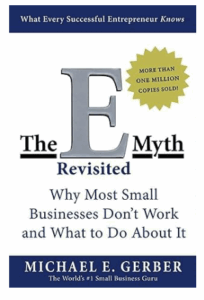If you’ve ever dreamed of starting your own business, or if you’re already running one and struggling to grow, Michael E. Gerber’s The E-Myth Revisited might be the answer to your prayers. First published in 1995, this book has helped millions of entrepreneurs learn what it takes to build an organization that lasts. Here are the E-Myth Revisited key concepts to know.
The E-Myth Revisited Summary
There’s a reason that The E-Myth Revisited is one of the most recommended business books of all time. The “e-myth” in question is the entrepreneurial myth—the mistaken belief that understanding the technical work of a particular business or industry automatically qualifies you to build and run a company.
This belief often leads business owners to spend too much time working in the business rather than on it, a common mistake among startup businesses. They usually struggle with task delegation and establishing the necessary systems to scale their organization.
If You Are Considering Starting a Business, Read the Book The E-Myth Revisited First
Lesson 1: Being Great at the Work Doesn’t Mean You Know How to Run a Business
Gerber’s central argument is straightforward: one reason small businesses fail is that their founders, rather than being true entrepreneurs who innately understand how to run a business, are technicians who excel at the day-to-day aspects of the work.
This is the first of the E-Myth Revisited key concepts, and it’s a tough pill for many to swallow. The skills required to deliver excellent work are entirely different from the skills needed to manage operations, develop strategies, market your services, and lead a team.
Lesson 2: You Wear 3 Hats — Whether You Realize It or Not
Gerber explains the internal struggle that most business owners face, which is that every business owner must play three distinct roles, each with competing priorities and perspectives: the technician, manager, and entrepreneur.
The Technician
The first role is the Technician. The technician lives by the maxim “if you want something done right, you have to do it yourself.” This role is essential—someone needs to create the actual product or service—but when the technician aspect of a business owner is dominant, they become trapped doing everything themselves, creating a cap on potential growth.
The Manager
The Manager craves order, predictability, and control. This personality type focuses on creating systems, establishing processes, and ensuring consistency. While sometimes viewed as bureaucratic, this role is critical for scaling operations and maintaining quality as a business grows.
The Entrepreneur
The Entrepreneur is the visionary, the dreamer who sees possibilities and opportunities everywhere. The entrepreneur provides the creative energy that launches the business, but often lacks the patience for operational details.
According to Gerber, successful businesses require a balance of all three roles, with an ideal distribution of roughly 10% Entrepreneur, 20% Manager, and 70% Technician during execution—but most failing business owners are 70% Technician, with the other roles seriously lacking.
Lesson 3: Work ON Your Business, Not IN It
The third key concept from The E-Myth Revisited is to allocate time each week for developing your business. Working in your business involves performing daily technical tasks, such as client consultations, product creation, and order fulfillment.
Working on your business, on the other hand, involves creating a strategy, building systems, and developing processes that enable the company to operate effectively without you. Most entrepreneurs spend all their time working in their business, leaving no time for the strategic work that would actually help it grow.
Lesson 4: Think Like a Franchise Builder, Even If You Never Franchise
Whether you’re opening a McDonald’s in Tokyo or Toronto, the experience is consistent because every aspect has been documented, systematized, and made repeatable. However, you don’t actually need to franchise your business to benefit from this mindset.
Ask yourself: “If I got hit by a truck tomorrow, could someone else run my business using a detailed operations manual?” Although creating this level of documentation and standardization might seem tedious, it’s what enables businesses to scale. Simplifying business processes to make them transparent and replicable is key.
Lesson 5: Build an Org Chart — Even If It’s Just You
Gerber recommends creating an organizational chart that outlines all the roles your business needs to function, such as marketing director, head of sales, customer service lead, and more. Even if you’re currently handling all of these duties yourself, seeing them mapped out helps you understand the full scope of what running a business entails.
Lesson 6: Systems Create Freedom, Not Control
The last of the six E-Myth Revisited key concepts revolves around systems. Gerber asserts that properly designed small business systems create freedom in your business. When you have documented processes for recurring tasks and decisions, you free up mental energy for creativity and strategy.
The E-Myth Revisited key takeaways make clear that building a successful business requires more than passion and technical skill—it also demands a fundamental shift in how you think about your role. Finding balance isn’t easy, but it works.
What’s holding you back from working on your business right now? Click here and sign up for my weekly articles on the keys to entrepreneurial success. If you need a business coach to help you implement these E-Myth Revisited key concepts in your business, click here to schedule a meeting.
Coach Dave
- If You Are Considering Starting a Business, Read the Book The E-Myth Revisited First - October 16, 2025
- Here’s a Must-Read Book: The Four Disciplines of Execution - October 9, 2025
- Don’t Procrastinate: It’s Time to Do Company Succession Planning - October 2, 2025


